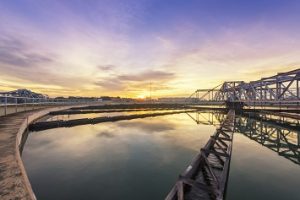America’s wastewater treatment infrastructure has logged impressive achievements over the 40-plus years since the Clean Water Act (CWA) was enacted. For example, the EPA reports that between 1968 and 1995, oxygen-depleting pollution discharged from sewage treatment plants nationwide declined by 45 percent despite increased industrial activity and a 35 percent growth in population.

But municipalities are currently facing other wastewater infrastructure challenges for which sources of funding are gravely inadequate. The most obvious solution is for the federal government to provide more money to the states that can then fund new and improved wastewater treatment systems at the local level. But other approaches, including changing the way existing funds are distributed and used, finding new ways to generate funds, and increasing assistance to disadvantaged communities, are also being considered.
Congress has recognized that measures to address emerging wastewater control issues are necessary, and a range of bills with different solutions have been introduced in the current session. The Congressional Research Service (CRS) recently reported on infrastructure challenges, existing and anticipated funding needs, and the content of some proposals offered by lawmakers.
$197 Billion Needed
The CRS report notes that the federal government has provided $95 billion in CWA assistance has been provided since 1972. But funding needs for wastewater infrastructure remain high. According to the most recent estimate by the EPA and the states, the nation’s wastewater treatment facilities will need $271 billion over the next 20 years to meet CWA’s water quality objectives. This estimate includes $197 billion for wastewater treatment and collection systems; $48 billion for combined sewer overflow (CSO) corrections; $19 billion for stormwater management; and $6 billion to build systems to distribute recycled water. These estimates do not include potential costs, largely unknown, to upgrade physical protection of wastewater facilities against possible terrorist attacks that could threaten water infrastructure systems.
Bills in Congress
The report lists 10 bills that include wastewater infrastructure related provisions. These include:
- H.R. 465 (Water Quality Improvement Act of 2017) would codify an integrated plan and permit approach into the CWA, direct the EPA to carry out a pilot program to work with at least 15 communities desiring to implement an integrated CWA compliance plan and require the Agency to update its 1997 CSO affordability guidance document.
- H.R. 1068 (Safe Drinking Water Act Amendments of 2017) and H.R. 1071 (Assistance, Quality, and Affordability Act of 2017) would incorporate in the CWA a governor’s authority to transfer as much as 33 percent of either the annual drinking water state revolving fund (DWSRF) or the clean water state revolving fund (CWSRF)capitalization grant to the other fund.
- H.R. 1647 (Water Infrastructure Trust Fund Act of 2017) would direct the secretary of the Treasury to establish a voluntary product labeling system informing consumers that the manufacturer, producer, or other stakeholder is participating in the Water Infrastructure Investment Trust Fund and contributing to clean water. The secretary would provide a label for a fee of 3 cents per unit. Funds would be made available only when the CWSRF appropriation is not less than the average of the 5 preceding fiscal years. Funds made available for a fiscal year would be split equally between the CWSRF and DWSRF programs.
- H.R. 3009 (Sustainable Water Infrastructure Investment Act of 2017) would amend the tax code to provide that the volume cap for private activity bonds shall not apply to bonds for sewage (and drinking water) facilities.
- S. 518 (Small and Rural Community Clean Water Technical Assistance Act) would authorize the EPA to issue grants to qualified nonprofit entities to provide technical assistance to owners and operators of small and medium wastewater treatment facilities.
- S. 1137 (Clean Safe Reliable Water Infrastructure Act) would codify in the statute EPA’s existing WaterSense Program and reauthorize CSO grants under CWA Section 221.
The CRS report is here.
